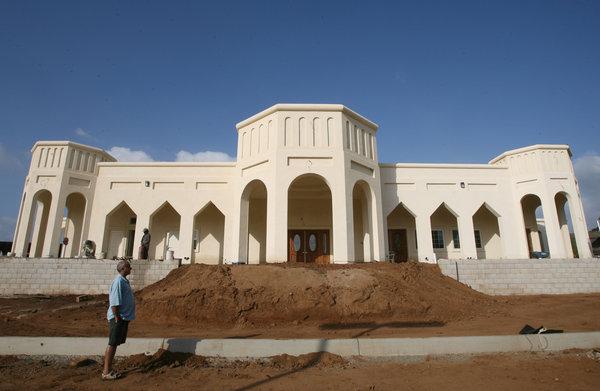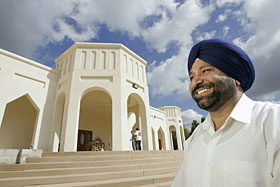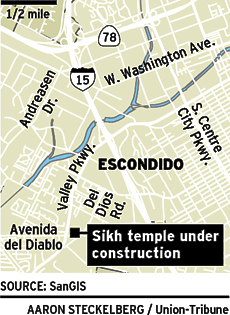New Gurdwara in San Diego

Sikh temple ready to meet area's spiritual needs By FRANK KOCHER November 28, 2008
ESCONDIDO ---- The culmination of a 13-year effort by the local Sikh community will occur next Friday, Dec. 5, when their new temple in Escondido holds its first worship service.
"This is a big moment for us. Some of our children were in kindergarten when we started and are now in college," said Baljit Singh Toor, the chairman of the board of the Sikh Society of San Diego.
Toor said that on Dec. 5, the temple, or gurdwara, as the Sikhs call it, will host a three-day ceremony known as Akhandh Path, during which the entire Sikh sacred scripture (Granth) is recited in an uninterrupted reading, a tradition for newly opened places of Sikh worship.
For the past 10 years, Sikhs (pronounced "seeks") in the Escondido, San Marcos and Temecula areas have been gathering at Del Dios Middle School for weekly religious services, Toor said ---- the next-nearest gurdwaras being in Poway and Riverside.
The new temple has 7,900 square feet and includes a large worship hall, a kitchen to prepare community meals, a room for a spiritual leader and restrooms. The building will serve a community of Sikh worshipers estimated by Toor at about 150 families. The gurdwara is near the southeastern corner of West Valley Parkway and Avenida del Diablo, and is on land purchased in 1995. The entire project cost about $1.5 million, which is being paid for by the local congregation.
"This is the first phase," Toor said. "The next step is to put three domes up, in three to four months." The domes are coming in pieces from the East Coast and will be assembled locally.
"In six to 12 months, we will be in the following phase, with a Sunday school for children aged 4 to 16, and a dining hall."
Sikhism is the fifth-largest organized religion in the world, with more than 23 million followers, according to several online resources. It originated in the Punjab region of northern India in the early 15th century. The word Sikh means "disciple" or "learner" in Sanskrit. Founded on the teachings of the guru Nanak, the faith grew in the region during the time of this first guru (teacher) and nine subsequent Sikh gurus. The teachings of the gurus and other writings compose the Guru Granth Sahib, which is the holy scripture of the Sikh faith. Among other writings, this scripture includes about 3,000 poetic compositions, many of them hymns.
The teachings of the Sikh gurus differed greatly from the dominant Hindu beliefs in the area at the time. Unlike Hinduism, Sikhism is monotheistic ---- but unlike the Abrahamic monotheistic faiths of Christianity, Judaism and Islam, Sikhs believe in Vahiguru, the Universal God, also known as the Akal Purakh, or Timeless Being.
Through disciplined, personal meditation on the name and messages of this non-humanlike God, followers of Sikhism pursue liberation and the realization of truth. The Sikh faith places much emphasis on attaining harmony with the message of the Vahiguru, despite man's tendency for inherent self-centeredness. The reward is liberation from an otherwise endless cycle of transmigration and rebirth, to a goal of a mystical union in eternal serenity with the Universal God.
Though there is no formal priesthood, gatherings for Sikh worship are led by a granthi, or "keeper of the scripture." The granthi leads the congregation in readings of scripture and singing hymns to musical accompaniment and reciting prayers, called ardas, before concluding by reading a hymn from scripture.
Many Sikh men wear their hair uncut, and many cover their heads with a cloth turban. They also may carry specific articles as part of their faith, such as a comb, a steel bracelet, a small sword or blade, and specially cut shorts.
Sikh worshippers traditionally bring food to prepare and share a meal in a large kitchen ---- it is considered part of the devotional experience. This community activity also shows a distinction between the caste system prevalent in India and its rejection by the Sikhs, who believe in equality of all humans.
One benefit to the local Sikh community of having their own gurdwara instead of renting space in a public school is having an area to prepare meals for the weekly services. Toor said the meals, Punjabi vegetarian dishes, are prepared at every service by a family that volunteers.
"Services are held every Sunday." said Toor. "Sikhs observe special days for the 10 Gurus. The day of birth, of passing, and also when the last guru passed away is observed. There will be plenty of room for these observances in the new gurdwara.
"Then, we will be reserving the main hall for marriage ceremonies, instead of going to Riverside or Poway. In Sikhism, marriages are required to be held in front of the granth."
For those who are curious, visitors are welcome, although they are asked to abide by Sikh customs.
"Services are open to everyone, as long as they take off their shoes and cover their heads," Toor said ---- adding that hair coverings are provided by the church for visitors' use.
More news

photo: CHARLIE NEUMAN / Union-Tribune
A temple for the next generation - After 15 years, Sikh Society to open hall, thanks to contributions from its members.
- Article by Angela Lau, UNION-TRIBUNE STAFF WRITER. November 9, 2008
At Valley Parkway and Avenida del Diablo, a striking, light yellow, Eastern-looking temple is almost ready for its first service.
It has taken the Sikh Society of San Diego 15 years to build this $1.5 million gurdwara.
When services begin, tentatively on Dec. 7, it will become the second of just two Sikh temples to serve 500 families from Riverside to Chula Vista. Of those, 150 families will attend the Escondido temple. The rest go to a temple in Poway or elsewhere.
“This is a very important moment for us. We wanted to build this for our kids, the next generation, so they have a place to worship,” said Baljit Singh Toor, chairman of the Sikh Society.
Services are currently held at Del Dios Middle School twice a month on Sundays, although Sikhs pray more often than that – daily at sunrise and sunset.
“It is not convenient. We want a place where people can walk in anytime and pray,” Toor said.
Sikhs (sikh means seeker of truth) practice Sikhism, a minority religion in India founded by Guru Nanak about 500 years ago in the Punjab area, in the northern and eastern regions of India. Today, an estimated 20 million people practice the religion worldwide.
Sikhism worships one God without human form, and it teaches followers to merge with God through religious devotion, meditation and service, and to live in peace and with integrity. Sikhs reject the use of idols and statues as well as the caste system.
That's why the walls of the Escondido temple will not have paintings of humans or deities.
Sikhs revere a holy book called the “Guru Granth Sahib,” a large 1,430-page Collections of the writings of the 10 Sikh Gurus, which included many passages from Hindu and Muslim sages as well, written in Gurmukhi, an official language and script of India. The Granth will be placed in the middle of the worship hall. During services, it will be read by volunteers or a Granthi (lit. a Granth reader), if the Sikhs hire the teachers well trained in the Sikh Religion, from India.
Another distinguishing characteristic of Sikhism is the full equality of women, an idea advanced by Guru Nanak in the 15th Century. In the temple, men and women enter together and sit in the same hall, although on different sides, as custom dictates. Both genders can take turns reading from the the holy Granth during services.
Years in the making
At Avenida del Diablo, the Sikhs' dream began in 1993 when they bought the 1.29 acres for $125,000, Toor recalled.
HIGHLIGHTS
- Sikh Society of San Diego Temple Location: 1838 Avenida Del Diablo, Escondido.
- Size: Phase I is a 6,000-square-foot worship hall with a kitchen. Phase II will add a Sunday school and dining room.
- Religion: Sikhism, an Indian religion founded about 500 years ago by Guru Nanak.
- Cost of temple: $1.5 million.
- Opening: Tentatively Dec. 7
The land was cheap, and Escondido seemed diverse enough to be religiously tolerant.
In 1994, the city approved a temple that would have looked like a house, said city associate planner Jay Paul.
But when the Sikhs realized how much they would have to spend to build it, they decided they'd rather have a temple that has the architectural flair of traditional temples – high ceilings, cavernous worship halls and signature gold domes.
But the redesigned structure, a replica of a Punjab temple, was rejected by the Planning Commission in 1998 on the basis that the architecture was incompatible with the neighborhood.
The Sikhs appealed to the City Council, which decided that the gold domes could stay, but the temple should be smaller.
“We have never rejected a church,” Mayor Lori Holt Pfeiler said.
The Sikhs reduced the size and agreed to use matte gold paint for the domes to ease concerns over the brightness of shiny gold domes.
In 2005, the foundation was poured. But the Sikhs quickly found that no bank would lend money to them because they had already started construction, Toor said.
That's when 17 members volunteered to each pay $5,100 every year and $101 a month to help maintain the temple. Sikhs like odd numbers because they believe if they give one, they will receive two in return.
Those 17 became members of the board of trustees.
Next, the Sikhs asked each child in the society to give up $100 of their spending money to finance the 25 fans needed for the worship hall and the dining area.
Last, they asked individuals to sponsor equipment. An Indian restaurant donated blinds for the kitchen. A family donated the carpet for the worship hall, and 13 families footed the bill for 13 parking lot lights.
Last week, Sikh Society leaders stood in the bright morning sun to savor the grandeur of the product of their collective efforts.
Sikh Society President Amritpal Singh Takhar was so proud he even showed off two ground-level sinks where worshippers wash their hands and feet before taking off their shoes to enter and worship.
Once inside, they cover their heads with turbans or handkerchiefs, and they sit on the floor cross-legged, with their soles pointing away from the holy book.
After each service, a free vegetarian meal is served in the attached communal kitchen, and old Sikh tradition called (Langar).
“We feed the hungry. We never turn anyone away,” Toor said. “Anyone is welcome to our services and meals.”
December opening
If all goes according to plan, and the temple opens Dec. 7, it may seem a little naked without its three gold domes.
They have not been manufactured and will not be installed until six months later, as part of a second construction phase, which will include Sunday school and a dining area, Toor said.
The Sikh Society is negotiating with a manufacturer in Maryland that makes custom domes for Indian temples in the United States.
Instead of using the traditional concrete or marble, the Maryland dome-maker, Didar Singh Rehsi, a descendant of Indian dome manufacturers, uses fiberglass for ease of transport and to avoid crushing the wood-framed structure underneath.
The domes would be made in segments, sprayed with a long-lasting metallic gold paint, and transported by trucks to Escondido, where they would be installed with the help of a crane, he said.
They would be a far cry from the splendor of the beloved main temple in Punjab, the Golden Temple, so-called because its second floor is covered with gold from top to bottom including the inverted lotus shaped dome.
But the half-spheres will do, Toor said. The large one will be in the center, measuring 16 feet high – including a 5-foot spire – and 12 feet wide.
It will be flanked by two smaller domes measuring 12 feet high – including a 4-foot spire – and 8 feet wide.
It's been a long and difficult road, Toor said, but they will not rest until everything is in place.
“This is a community effort. Everyone pitches in,” he said. “We don't put any names on anything because we wanted this temple, so we contributed and volunteered.”

